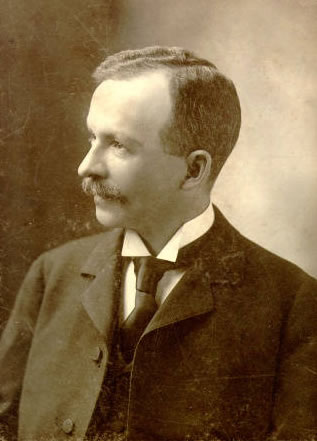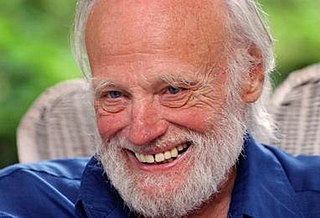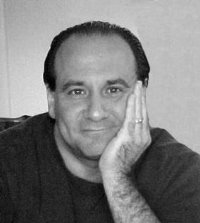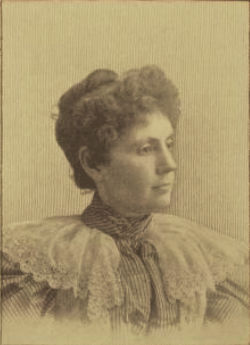
Robert William Chambers was an American artist and fiction writer, best known for his book of short stories titled The King in Yellow, published in 1895.

Charles Waddell Chesnutt was an American author, essayist, political activist and lawyer, best known for his novels and short stories exploring complex issues of racial and social identity in the post-Civil War South. Two of his books were adapted as silent films in 1926 and 1927 by the African-American director and producer Oscar Micheaux. Following the Civil Rights Movement during the 20th century, interest in the works of Chesnutt was revived. Several of his books were published in new editions, and he received formal recognition. A commemorative stamp was printed in 2008.

William Dudley Pelley was an American fascist activist, journalist, writer and occultist, noted for his support of German dictator Adolf Hitler during the Great Depression and World War II.
Charles Frazier is an American novelist. He won the 1997 National Book Award for Fiction for Cold Mountain.

Southern United States literature consists of American literature written about the Southern United States or by writers from the region. Literature written about the American South first began during the colonial era, and developed significantly during and after the period of slavery in the United States. Traditional historiography of Southern United States literature emphasized a unifying history of the region; the significance of family in the South's culture, a sense of community and the role of the individual, justice, the dominance of Christianity and the positive and negative impacts of religion, racial tensions, social class and the usage of local dialects. However, in recent decades, the scholarship of the New Southern Studies has decentralized these conventional tropes in favor of a more geographically, politically, and ideologically expansive "South" or "Souths".

Charles Eugene Fager, known as Chuck Fager, is an American activist, author, editor, publisher and an outspoken and prominent member of the Religious Society of Friends or Quakers. He is known for his work in both the Civil Rights Movement and in the Peace movement. His written works include religious and political essays, humor, adult fiction, and juvenile fiction, and he is best known for his 1974 book Selma 1965: The March That Changed the South, his in-depth history of the 1965 Selma Voting Rights Movement, which led to the passage of the Voting Rights Act.

Augusta Jane Wilson, was an American author of Southern literature and a supporter of the Confederacy during the American Civil War. Her books were banned by the American Library Association in 1881. She was the first woman to earn US$100,000 through her writing.

Caroline Pafford Miller was an American novelist. She gathered the folktales, stories, and archaic dialects of the rural communities she visited in her home state of Georgia in the late 1920s and early 1930s, and wove them into her first novel, Lamb in His Bosom, for which she won the Pulitzer Prize for Fiction in 1934, and the French literary award, the Prix Femina Americain in 1935. Her success as the first Georgian winner of the fiction prize inspired Macmillan Publishers to seek out more southern writers, resulting in the discovery of Margaret Mitchell, whose first novel, Gone with the Wind, also won a Pulitzer Prize for Fiction in 1937. Miller's story about the struggles of nineteenth-century south Georgia pioneers found a new readership in 1993 when Lamb in His Bosom was reprinted, one year after her death. In 2007, Miller was inducted into the Georgia Writers Hall of Fame.

Cold Mountain is a 1997 historical novel by Charles Frazier which won the U.S. National Book Award for Fiction. It tells the story of W. P. Inman, a wounded deserter from the Confederate army near the end of the American Civil War who walks for months to return to Ada Monroe, the love of his life; the story shares several similarities with Homer's Odyssey. The narrative alternates every chapter between the stories of Inman and Ada, a minister's daughter recently relocated from Charleston to a farm in a rural mountain community near Cold Mountain, North Carolina, from which Inman hails. Though they only knew each other for a brief time before Inman departed for the war, it is largely the hope of seeing Ada again that drives Inman to desert the army and make the dangerous journey back to Cold Mountain. Details of their brief history together are told at intervals in flashback over the course of the novel.
Clyde Edgerton is an American author. He has published a dozen books, most of them novels, two of which have been adapted for film. He is also a professor, teaching creative writing.
James Reasoner is an American writer. He is the author of more than 350 novels and many short stories in a career spanning more than thirty years. Reasoner has used at least nineteen pseudonyms, in addition to his own name: Jim Austin; Peter Danielson; Terrance Duncan; Tom Early; Wesley Ellis; Tabor Evans; Jake Foster; William Grant; Matthew Hart; Livia James; Mike Jameson; Justin Ladd; Jake Logan; Hank Mitchum; Lee Morgan; J.L. Reasoner ; Dana Fuller Ross; Adam Rutledge; and Jon Sharpe. Since most of Reasoner's books were written as part of various existing Western fiction series, many of his pseudonyms were publishing "house" names that may have been used by other authors who contributed to those series.

John Marsden Ehle, Jr. was an American writer known best for his fiction set in the Appalachian Mountains of the American South. He has been described as "the father of Appalachian literature".
North and South is a 1980s trilogy of best-selling novels by John Jakes which take place before, during, and after the American Civil War. The saga tells the story of the enduring friendship between Orry Main of South Carolina and George Hazard of Pennsylvania, who become best friends while attending the United States Military Academy at West Point but later find themselves and their families on opposite sides of the war. The slave-owning Mains are rural gentleman planters while the big-city Hazards live by manufacturing and industry, their differences reflecting the real divisions between North and South which ultimately led to war.
Avery Odelle Craven was an American historian who wrote extensively about the nineteenth-century United States, the American Civil War and Congressional Reconstruction from a then-revisionist viewpoint sympathetic to the Lost Cause as well as democratic failings during his own lifetime.
Sara Gruen is Canadian-American author. She is a 2007 recipient of the Alex Award for young adult literature.

The Valley River is a tributary of the Hiwassee River. It arises as a pair of springs in the Snowbird Mountains of Cherokee County, North Carolina and descends 2,960 feet (900 m) in elevation in approximately forty miles (64 km) to enter the Hiwassee embayment at present-day Murphy, North Carolina.

Theodore P. Savas worked an attorney for many years, was a former adjunct college instructor, and is an entrepreneur, award-winning author, and award-winning publisher. He is the co-founder and majority partner of Savas Beatie, an independent book trade publishing company that specializes in military and general history, and especially the American Civil War. He writes and speaks about Civil War topics, as well as the American Revolutionary War, and WWII German U-boats.
Charles Jacobs Peterson was an American editor, publisher and writer. He worked as an editor at Graham's Magazine, was an owner and partner of The Saturday Evening Post, and founded Peterson's Magazine. He published several fictional and non-fictional history books under his own name and the Anti-Tom literature novel The Cabin and Parlor; or, Slaves and Masters under the pseudonym J. Thornton Randolph. He was a member of the Peterson family of publishers including his cousins Robert Evans Peterson and Henry Peterson.

Frances Tiernan was an American author who wrote more than 50 novels, most notably The Land of the Sky. Reared as a Roman Catholic, she grew up in the Southern United States.

G-8 and His Battle Aces was an American air-war pulp magazine published from 1930 to 1944. It was one of the first four magazines launched by Popular Publications when it began operations in 1930, and first appeared for just over two years under the title Battle Aces. The success of Street & Smith's The Shadow, a hero pulp, led Popular to follow suit in 1933 by relaunching Battle Aces as a hero pulp: the new title was G-8 and His Battle Aces, and the hero, G-8, was a top pilot and a spy. Robert J. Hogan wrote the lead novels for all the G-8 stories, which were set in World War I. Hogan's plots featured the Germans threatening the Allied forces with extraordinary or fantastic schemes, such as giant bats, zombies, and Martians. He often contributed stories to the magazines as well as the lead novel, though not all the short stories were by him. The cover illustrations, by Frederick Blakeslee, were noted for their fidelity to actual planes flown in World War I.
















